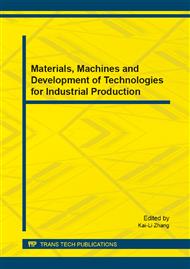[1]
P.F. Gostin, S. Oswald, L. Schultz, A. Gebert, Acid corrosion process of Fe-based bulk metallic glass, Corrosion Science. 62 (2012) 112-121.
DOI: 10.1016/j.corsci.2012.05.004
Google Scholar
[2]
Q.J. Chen, H.B. Fan, L. Ye, S. Ringer, J.F. Sun, J. Shen, D.G. McCartney. Enhanced glass forming ability of Fe-Co-Zr-Mo-W-B alloys with Ni addition. Materials Science and Engineering A. 402 (2005) 188-192.
DOI: 10.1016/j.msea.2005.04.046
Google Scholar
[3]
J. Shen, Q.J. Chen, J.F. Sun.Exceptionally high glass-forming ability of an FeCoCrMoCBY alloy. Applied Physics Letters, 86 (2005) 151907-151909.
DOI: 10.1063/1.1897426
Google Scholar
[4]
T. Aycan Baser, M. Baricco. Fe-based bulk metallic glasses with Y addition. Journal of Alloys and Compounds. 434-435 (2007) 176-179.
DOI: 10.1016/j.jallcom.2006.08.190
Google Scholar
[5]
S.L. Wang, H.X. Li, X.F. Zhang, S. Yi. Effects of Cr contents in Fe-based bulk metallic glasses on the glass forming ability and the corrosion resistance. Materials Chemistry and Physics. 113 (2009) 878-883.
DOI: 10.1016/j.matchemphys.2008.08.057
Google Scholar
[6]
A. Pardo, M.C. Merina, E. Otero. Influence of Cr additions on corrosion resistance of Fe- and Co-based metallic glasses and nanocrystals in H2SO4. Journal of Non-Crystalline Solids. 352 (2006) 3179-3190.
DOI: 10.1016/j.jnoncrysol.2006.05.021
Google Scholar
[7]
K. Asami, K. Kawashima, K. Hashimoto. Chemical properties and applications of some amorphous alloys. Materials Science and Engineering. 99 (1988) 475-481.
DOI: 10.1016/0025-5416(88)90380-1
Google Scholar
[8]
E. Akiyama, A. Kawashima, K. Asani, K. Hashimoto. The corrosion behavior of sputter-deposited amorphous Al Cr Mo alloys in 1 M HCl. Corrosion Science. 38 (1996) 279–292.
DOI: 10.1016/0010-938x(96)00119-9
Google Scholar
[9]
M.W. Tan, E. Akiyama, H. Habazaki, A. Kawashima, K. Asami, K. Hashimoto. The role of chromium and molybdenum in passivation of amorphous Fe-Cr-Mo-P-C alloys in deaerated 1 M HCl. Corrosion Science. 38 (1996) 2137-2151.
DOI: 10.1016/s0010-938x(96)00071-6
Google Scholar
[10]
J. Jayaraj, K.B. Kim, H.S. Ahn, E. Fleury. Corrosion mechanism of N-containing Fe-Cr-Mo-Y-C-B bulk amorphous alloys in highly concentrated HCl solution. Materials Science and Engineering A. 449-451 (2007) 517-520.
DOI: 10.1016/j.msea.2006.02.418
Google Scholar
[11]
Q.J. Chen, J.L. Liu, X.L. Zhou, J. Shen, X.Z. Hua. Effects of high Co contents in Fe-Cr-Mo-C-B-Y alloy on the glass forming and the mechanical properties. Advanced Materials Research Vols. 652-654 (2013) 1054-1058.
DOI: 10.4028/www.scientific.net/amr.652-654.1054
Google Scholar
[12]
Y.B. Wang, H.F. Li, Y.F. Zheng, M. Li. Corrosion performances in simulated body fluids and cytotoxicity evaluation of Fe-based bulk metallic glasses. Materials Science and Engineering C. 32 (2012) 599-606.
DOI: 10.1016/j.msec.2011.12.018
Google Scholar
[13]
R.M. Fernández-Domene, E. Blasco-Tamarit, D.M. García-García, J. García Antón. Passive and transpassive behaviour of Alloy 31 in a heavy brine LiBr solution. Electrochimica Acta. 95 (2013) 1-11.
DOI: 10.1016/j.electacta.2013.02.024
Google Scholar
[14]
W.J. Botta, J.E. Berger, C.S. Kiminami, V. Roche, R.P. Nogueira, C. Bolfarini. Corrosion resistance of Fe-based amorphous alloys. Journal of Alloys and Compounds. 586 (2014) S105-S110.
DOI: 10.1016/j.jallcom.2012.12.130
Google Scholar
[15]
B.M. Wei. Corrosion theory and application. Beijing, 1984: 124-126.
Google Scholar
[16]
D.W. Xing, J.F. Sun, J. Shen, G. Wang, M. Yan. The relations between ΔTx and the glass forming ability of bulk amorphous Zr–Cu–Ni–Al–Hf–Ti and Zr52. 5Cu17. 9Ni14. 6Al10Ti5 alloys. Journal of Alloys and Compounds. 375 (2004) 239-242.
DOI: 10.1016/j.jallcom.2003.11.155
Google Scholar


